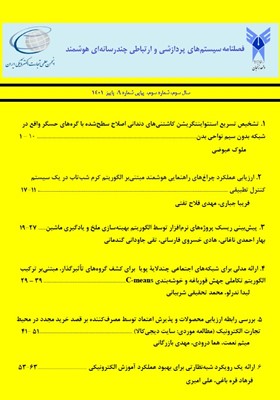ارایه یک رویکرد شبه نظارتی برای بهبود عملکرد آموزش الکترونیکی
محورهای موضوعی : پردازش چند رسانه ای، سیستمهای ارتباطی، سیستمهای هوشمندفرهاد قره باغی 1 , علی امیری 2 *
1 - دانشجوی دکتری، دانشکده مهندسی کامپیوتر و فناوری اطلاعات، واحد قزوین، دانشگاه آزاد اسلامی، قزوین، ایران
2 - دانشیار، گروه مهندسی کامپیوتر، دانشگاه زنجان، زنجان، ایران
کلید واژه: یادگیری الکترونیکی, دادهکاوی, یادگیری شبه نظارتی, یادگیری نظارتشده,
چکیده مقاله :
در عصر اطلاعات جهتگیری بسیاری از سامانهها به سمت شخصیسازی اطلاعات برای کاربر است. یادگیری الکترونیکی نیز از این قاعده مستثنی نبوده و یکی از ملزومات آن وجود مکانیزمی شخصیشده برای کمک به یادگیری مؤثر یادگیرنده است. در سالهای اخیر از روشهای دادهکاوی به طور گسترده در زمینه یادگیری الکترونیکی استفاده شده است. در واقع محققین مختلف با استفاده از روشهای دادهکاوی سعی در شناخت هر چه بیشتر یادگیرندگان و در نتیجه ایجاد یادگیری تطبیقی داشتهاند. در تحقیقات مختلف از یادگیری نظارت شده برای شناخت یادگیرندگان استفاده شده است. با توجه به معایب الگوریتم های یادگیری نظارت شده در این تحقیق جهت شناسایی سطح دانش یادگیرندگان یک مدل داده کاوی شبه نظارتی پیشنهادشده است تا بتواند با شخصیسازی و هوشمندسازی محیط یادگیری الکترونیکی، عملکرد یادگیری و رضایت مندی یادگیرندگان را بهبود بخشد. در این مقاله با استفاده از رویکرد دادهکاوی شبه نظارتی به شناسایی سطح دانش یادگیرندگان پرداخته شده است. به این منظور برای ایجاد مدل پیشنهادی از الگوریتم شبه نظارتی LP-MLTSVM استفاده شده است. در ساخت مدل پیشنهادی از داده های واقعی استفاده شده است. به منظور ارزیابی، در یک دوره مجازی از مدل پیشنهاد شده استفاده شد. نتایج حاصل از دوره موفقیت و رضایت تحصیلی یادگیرندگان با مدل پیشنهادی را نشان میدهد.
Introduction: Academic success of students is one of the important goals in educational environments. In recent years, with the rapid proliferation of information technology in the field of education has led to a new model called "electronic learning". Nowadays, the application of this technology in education has made the education process go beyond time, geographical and political limitations. Providing effective training is an example benefit of e-learning. Considering an appropriate teaching method improves the performance of learners in the educational environment. In traditional education, there is a direct interaction between the learner and the teacher, which makes it possible for the teacher to adapt the teaching method to the learner's conditions. In electronic education, the absence of this direct interaction demands methods for the personalization of education. In this paper, using the data mining approach, the knowledge level of the learners is determined. This knowledge can be observed and collected by the system. Intelligent educational systems use a model of the learner that represents the level of literacy and skill of the learner in a specific field, and use it to analyze the learner's inputs to the system during educational interactions.Method: In this paper, LP-MLTSVM semi-supervised learning method is used to improve the learning quality and the satisfaction of learners in e-learning. The LP-MLTSVM algorithm is a semi-supervised algorithm developed based on the support vector machine algorithm. The proposed model creates a multi-class classification. In the proposed model, the data of the electronic education center of Semin have been used. This center has about five thousand members, in which e-learning courses are conducted. In this method, all the training data are used in the construction of the model, with the difference that there is no need to label all the samples. In the proposed model, only 20% of the samples are labeled by an expert. 75% of the labeled data were used for training and 25% of them were used for testing the models.Results: To evaluate the effectiveness of using the proposed system in the held course, the criteria of "academic success" and "academic satisfaction" have been used. In each of the groups, at the end of the course, a comprehensive test of 40 questions was presented to the learners for evaluation. The purpose of this test is to measure the academic success of the students in the mentioned groups. This work was done in order to check the effect of the proposed groups in the system. To explore the effect of these groups, the one-way analysis of variance was used and the amount of difference between the results of the groups was checked. In order to check the learners' satisfaction with the methods used in the first, second and third groups, at the end of each session, a questionnaire containing four questions was presented to the learners. These questions have 5 options, option 1 indicates lack of satisfaction and option 5 indicates complete satisfaction with the course. The results show the success of the proposed method.Discussion: In the proposed method, the characteristics of the learners were investigated and suitable characteristics were created in order to predict the class variable which was the knowledge level of the learners. Then the research data was collected and solved using the proposed method. The results of the proposed method and the existing methods were compared with each other, and according to the evaluation criteria, the obtained results show that the proposed method is better. Finally, in order to evaluate, the presented model was used in a virtual course. The results of the course show the success and academic satisfaction of the students of the course with the proposed model.
_||_

